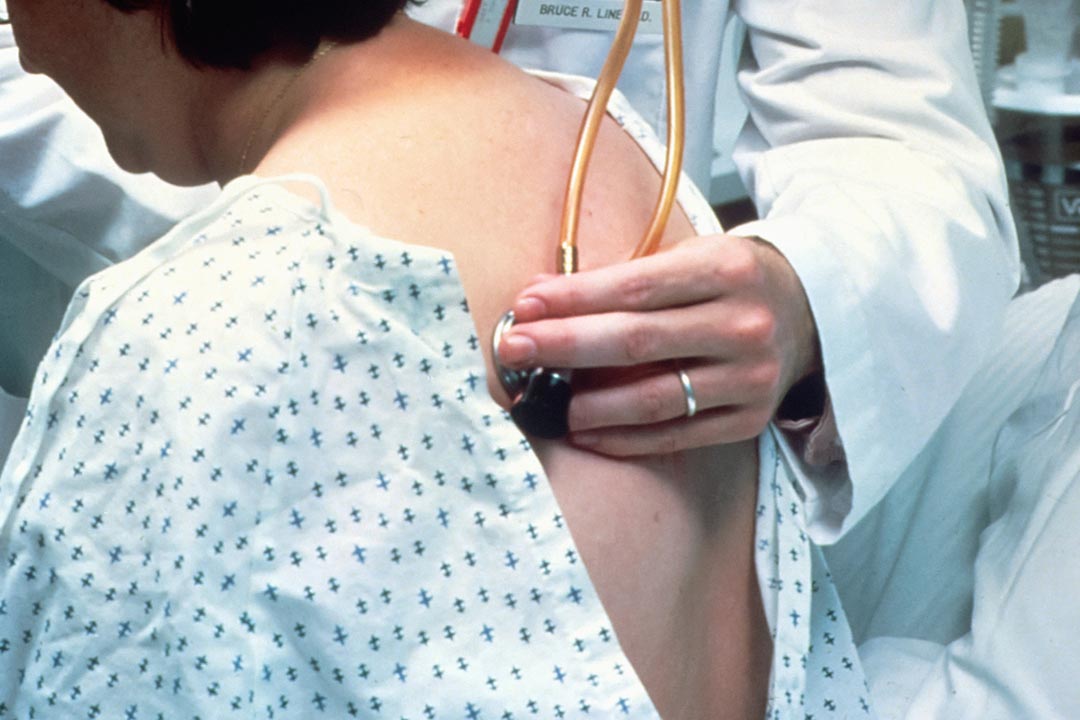A “tripledemic” of viruses is fuelling a surge in pneumonia, but what are the symptoms to look out for?
RSV, influenza and COVID-19 can all trigger pneumonia. Here’s what you should know about this lung infection.
- 19 January 2023
- 4 min read
- by Linda Geddes

The combination of influenza, COVID-19, and respiratory syncytial virus (RSV) is putting severe strain on hospitals in many countries. Although many people who are infected with these viruses will recover without any unexpected trouble, a minority will develop pneumonia and require hospital treatment.
Pneumonia is an infection of the lungs that can be caused by viruses, bacteria or fungi. The lungs are made up of tiny sacs called alveoli, which fill with air when we breathe, and move oxygen and carbon dioxide in and out of the bloodstream. Pneumonia causes these air sacs to fill up with pus and fluid, which makes it harder to breathe, and for our organs to get enough oxygen.
You should seek immediate medical attention if you experience difficulty breathing, develop a bluish colour in your lips or fingertips, have chest pain, a high fever, or a cough with mucus that is severe or getting worse.
People of all ages can develop pneumonia, and their symptoms can vary from being so mild that they barely notice them, to life-threatening. Approximately 20% of pneumonia patients will require hospital admission, and out of this group roughly 10% will need treatment in an intensive care unit.
How a person responds to pneumonia depends what's causing it, their age, and their overall health. Older adults, pregnant women and young children tend to be at greater risk, as are people with certain medical conditions, but anyone can develop the condition.
Causes
Generally speaking, viral pneumonias tend to last a shorter time than bacterial ones, although they can still be severe. SARS-CoV-2 and influenza are the most common viral causes in adults, while RSV is the most common cause in young children. To complicate matters, these respiratory infections can also predispose people to a secondary invasion of bacteria.
The most common cause of bacterial pneumonia is Streptococcus pneumoniae, also known as pneumococcus, which usually lives harmlessly in the upper airways. There are vaccines to help protect against pneumococcus, although these are mostly only offered to older adults, young children and those with certain medical conditions or other risk factors.
Fungal pneumonia tends to be more common in people with weakened immune systems or pre-existing health conditions, such as HIV or cancer, and among those working in jobs that may expose them to large doses of certain fungi found in soil or bird droppings.
Symptoms
Signs and symptoms of pneumonia can vary, but include: a cough, shortness of breath, rapid, shallow breathing, fever or chills, a sharp or stabbing chest pain that gets worse when you breathe deeply or cough, fatigue and loss of appetite, nausea and vomiting (especially in young children), and confusion (particularly in older adults).
However, pneumonia isn't something that you can necessarily diagnose by yourself, so you should call a doctor if you suspect you or your child might have it. And, according to the American Lung Association, you should seek immediate medical attention if you experience difficulty breathing, develop a bluish colour in your lips or fingertips, have chest pain, a high fever, or a cough with mucus that is severe or getting worse.
Have you read?
If you have access to a pulse oximeter, a device that measures oxygen levels in the blood, you should seek medical advice if your reading drops below 95%, while a blood oxygen saturation of 92% or below is usually a sign of serious illness, and should prompt urgent medical advice.
It's especially important to seek help if you are in a high-risk group, which includes older adults, children aged two or younger, and those with an underlying health condition or weakened immune system.
Treatment and recovery
Bacterial pneumonia usually requires treatment with antibiotics, either at home or in hospital. In severe cases, patients may need to be given antibiotics and fluids intravenously (e.g. through a drip), or oxygen therapy to help them breathe.
Antibiotics won't work against viral or fungal pneumonia, so people may be prescribed anti-viral or anti-fungal medications.
Rest and drinking plenty of fluids can also help people to recover more quickly, and the American Lung Association also recommends avoiding sources of smoke, drinking warm beverages, and taking aspirin, non-steroidal anti-inflammatory drugs such as ibuprofen, or acetaminophen (paracetamol) to control fever – although aspirin should NOT be given to children. Because coughing can help to clear the infection, you should not take cough medicines without speaking to a doctor first.
Most people will recover from pneumonia, but this can take time. Although some people may feel ready to resume normal routines within a week, this can take a month or longer, and it is also normal to feel tired for about a month.
You can reduce the risk of pneumonia by getting the pneumococcal vaccine (if you or your child are eligible,) and the annual influenza vaccine, as flu is a common cause. Since whooping cough, measles, and Haemophilus influenzae type B (Hib) can also trigger pneumonia, it is important to stay up to date with these vaccinations.
More from Linda Geddes
Recommended for you








